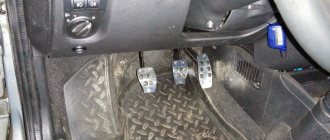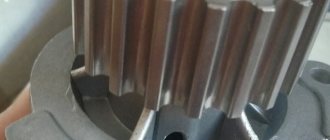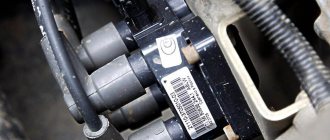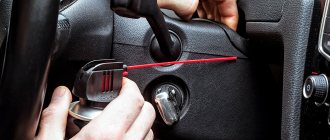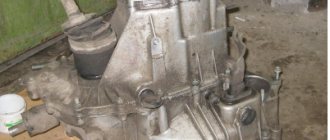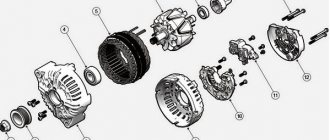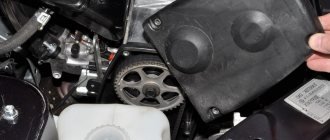The clutch pedal position sensor on the Lada Grant is fixed on the clutch pedal bracket. To see it, just look under the steering column at the base.
Clutch sensor
Violation of vehicle operating conditions leads to premature wear of the sensor and incorrect engine operation.
Pedal under the steering column
To restore the machine's performance, it is necessary to replace the clutch sensor (hereinafter referred to as DS).
The process is not complicated, but it requires increased attention and precision from the repairman. Do not damage the vehicle's electronic control unit.
Operating principle of the electronic engine control system (ECM)
In a modern car, all process control, except for the rotation of the steering wheel, and even then, is entrusted to the computer, or Electronic Control Unit (ECU). It contains a program with many different tables. In general, the ECU receives data about the state of the car, speed, revolutions, and activated mechanisms from a large number of sensors. Based on the results of these observations, the ECU, using these tables, includes certain ignition modes, fuel supply and other executive functions.
Symptoms of this part being faulty
Since this element is connected to the ECU, it reacts to its failure first of all. That is, it gives peculiar signals that are reflected on the instrument panel and are noticeable in the behavior of the Priora when driving.
- turning on the “Check Anger” light;
- twitching when starting to move;
- a sharp drop or, conversely, an increase in speed when the clutch is engaged.
There can be three malfunctions in total: a breakdown of the sensor itself, a break or short circuit in its circuit, and incorrect adjustment of the position of the limit switch on the pedal.
Attention! Only Prioras, which have an electronic throttle, are equipped with such a device. Cars with a regular throttle cable do not have one. It is also available for all-wheel drive VAZ. It must be remembered that these are two types of sensors, and they are not interchangeable!
In general, the “Check” warning lamp lights up in cases where the ECU has not received a signal within 2 seconds when starting from a stop or during four shifts on the move without a signal. Accordingly, the signs mentioned above appear.
Debugg
Alas, as practice shows, at the moment this sensor is not always on sale. But you need to remember that the most common malfunction is the separation of the wire from the limit switch contacts. And they are easy to solder. In general, first you need to visually make sure that the pedal pusher presses properly on the limit switch. Visually check the condition of the wires. And only after that remove it. This is a simple procedure. The clutch sensor is attached with only two self-tapping bolts, and it is not difficult to remove it with a short, shaped screwdriver. Well, then, on the spot, decide whether to start going to retail outlets in search of a new unit, or try to restore the old part. Well, put it in its place. After finishing work on the Priora, do not forget to reset the ECU error memory.
The popular Priora was designed in the spirit of the times, so the computer even controls such a unit as the clutch. The electronics do not control the process of turning the clutch on and off, but the clutch sensor on the Priora, installed under the clutch pedal, collects information about the position of the pedal. This data enters the electronic engine control unit and is used to optimize engine operation depending on the driving mode, and also makes it possible to use cruise control on the car.
Why does it break and can it be fixed?
If we ignore the very obvious reasons, such as a broken wire caused by the driver's foot, there is only one reason left for repair or replacement. Failure of the micro-switch (in simple terms: “micrika”). This is pure mechanics: the sensor works intensively, and natural wear occurs.
The first thought of a car owner who knows how to hold a soldering iron in his hands is to replace the Mikrik itself.
As a temporary measure, it is quite suitable. However, it is necessary to accurately select the geometry of the switch and its dimensions. In addition, “micrics” that work in consumer electronics are not designed for intensive use, and will most likely quickly fail.
How does the electronic engine management system work?
The electronic engine control unit controls most of the vehicle's components, excluding the steering and suspension. ECU programs include presets (tables), according to which optimal operating modes are calculated. Many sensors installed on the car read information about speed, movement, engine speed, activated mechanisms and units. Based on the tables, the ECU changes the ignition mode, turns on additional functions and regulates the composition and amount of the air-fuel mixture entering the cylinders.
Conclusion
The design of the clutch sensor is completely copied from Renault Logan, so claims about the imperfection of the system are unfounded.
Violation of service life, aggressive driving style, purchase of cheap spare parts are the main factors contributing to premature wear of mechanisms and assemblies. The process of replacing the clutch sensor will not take much time. The work can be done by a car owner without skills or special equipment.
| Video - Lada Granta - Error p0830 Clutch sensor malfunction |
| Video - Clutch sensor or Error P0830 on Lada Granta |
Functions of the Priora clutch sensor
Data about the current mode of the clutch mechanism is important for engine control. If the clutch is open, it is necessary to reduce the fuel supply and reduce engine speed. It is optimal to do this in accordance with the current speed of the vehicle, without switching to idle mode. A driver, especially an inexperienced one, may make mistakes, which leads to increased load on the engine and clutch. The on-board computer, based on the readings of the clutch sensor, adjusts the engine operating mode, setting the optimal speed. Also, the clutch sensor on the Priora, in combination with the speed sensor, allows the computer to evaluate the performance of the unit and signal problems.
Installing a clutch sensor on a Priora allowed:
- reduce fuel consumption;
- make driving easier and more enjoyable;
- control the serviceability of the coupling;
- extend clutch life.
Therefore, the serviceability of the sensor affects the service life of the units, fuel consumption and is extremely important for the correct operation of the ECU.
Operating principle of the Priora clutch sensor
What is a Priora clutch sensor? The operating principle of the device is no different from a simple limit switch. When the pedal is not pressed and the clutch is engaged, the sensor contacts are open. When you press the clutch drive, the limit switch closes, sending a signal to the computer to separate the clutch disc and basket.
The clutch sensor is installed on the pedal mounting assembly so that the tip of the pedal touches the limit switch.
The sensor design is simple and reliable, but this does not exclude the possibility of breakdowns and malfunctions in its operation.
Absolute pressure and air temperature sensors for Lada Granta
These sensors are combined into one housing and installed on the receivers of the intake module; the most modern AvtoVAZ engines are equipped with them.
New Lada: Lada Granta automatic transmission repair in Tomsk. Affordable prices on PROFI.RU. Read reviews, choose according to specialist ratings
DBP on Grant differs in the output signal voltage within the range of 0.15..4.6 V, this voltage depends on the pressure level inside the intake pipe. The information it sends helps the ECU calculate the amount of air received by the intake pipe during one cycle.
A breakdown of the device circuit leads to an error code being entered into the system memory, and then the alarm turns on. After this, the control system calculates the air received based on the crankshaft speed, as well as based on the throttle valve opening angle.
The sensitive component of the DTV is the inlet pipe thermistor. The output signal voltage of the device connected to the computer will be approximately 0.3..4.9 V, it depends on the temperature of the air passing through the specified element. When a DTV failure is detected, the control system performs actions similar to its actions in the event of a DBP failure on a Lada Granta, replacing the readings of the described device with fixed temperature values.
Replacing the Priora clutch sensor
To dismantle the Priora clutch sensor, you just need to unscrew the two screws holding it to the clutch pedal. But to get to them, you need to do a lot of operations. Removing the Priora clutch sensor is done as follows:
After removing the sensor, you can replace it with a new one or repair it.
The sensor is installed like this:
- secure the sensor with self-tapping screws;
- install the rubber clutch pedal cover;
- install frill;
- secure the windshield wiper blades.
When adjustment is required
Clutch adjustment is only performed when the engine is switched off. It is required if there is a deviation from the following values:
- full pedal travel does not exceed 146 mm;
- movement of the cable lead relative to the release fork lever - within 270 mm;
- runout of the dependent disc linings does not exceed 0.5 mm;
- the distance between the pads and the rivets that hold them is 0.2 mm or less.
There are several ways to check if your car needs a clutch adjustment.
- You should press the pedal several times in a row and listen for any extraneous noise. If the clutch pedal sticks or squeaks, it is advisable to make an adjustment. In some cases, car owners are unable to visually assess whether the pedal returns to its place freely. In such situations, it is recommended to do the following:
- press the clutch with your hand until it stops;
If the clutch pedal sticks and clicks, or it returns to its original position with characteristic jerking, you need to adjust the clutch.
It is necessary to measure the distance from the floor to the outer part of the pedal using a ruler or caliper. Then press the pedal until it hits the floor. After this, you need to release the pedal and take measurements again. If the distance exceeds 146mm, be sure to adjust the clutch.
Return to contents
Repair of the Priora clutch sensor
Often, sensor malfunctions can be easily resolved without replacing it.
First you need to check whether the sensor end reaches the clutch pedal pusher. If the pusher does not press on the limit switch, it is necessary to adjust the position of the sensor relative to the pedal.
Another common failure is a break in the wires going to the sensor contacts. This malfunction can be easily detected by checking that the wires are securely fixed with your fingers. To fix this problem, you need a soldering iron, solder and rosin. When the sensor is removed from the car, soldering wires to its contacts is not difficult.
If the sensor wires are not broken and the limit switch reaches the pusher, the problem may be a faulty sensor contact or a broken limit switch. They may oxidize, become deformed or break. The functionality of the contacts can be checked using a multimeter. To do this, you need to connect the device to the sensor terminals and check the change in resistance between them when you press the limit switch.
Oxidized contacts can be cleaned, restoring the functionality of the sensor. If this does not work, it should be replaced. The price of this part is low, and you can buy it at most auto stores.
Replaced the clutch sensor. This sensor is located in the cabin, directly above the clutch pedal. You can say at its axis of rotation (or whatever it is called), in short, where it is attached.
This is what the clutch sensor looks like with a wire and a connector.
As far as I know and understand, this sensor is only installed on cars with E-gas, but there are no throttle position and idle speed sensors. But all this is answered by E-gas. If I'm wrong, please correct me. The first symptom is that the clutch sensor is dead - Jackie Chan came to visit me. To be honest, I didn’t even do the diagnostics. The most interesting thing is that the check light came on after about 400-500 km, when it started to become really dull. It’s interesting that the sensor started to go dull yesterday. The next day I start it, drive and everything is fine. But over time, everything is new again. Or it could all stop before I got home, and the next day it would start drizzling again in the morning. In short, nothing is clear))).
And it slows down in the following way: when changing gears (let’s say from 3 to 4), you squeeze the clutch and the rpms immediately jump by about 500 (maybe a little more). Or in another way: you are accelerating or driving at one speed and decided to switch, and then when you press the clutch the car itself picks up speed and immediately drops it. But if you first release the gas, then wait 1-2 seconds. and squeeze the clutch, the revs do not jump. And not long before the death of this sensor there was one strange thing. The car started to jerk at low speeds, about 1000-1200 rpm, no matter what gear. I read about this crap on the Internet and decided to change this sensor. By that time, my check had not yet cleared. As soon as I bought the sensor, I drove 300-400 meters away from the market and the check light came on.
And here's a little story about the search for the sensor. The first thing I did was call the store where they sell spare parts from the factory. They said he wasn't there. They constantly give applications for it, but don’t deliver it. Then I called the 2nd office. to dealers. The first one said that it was there. Price 500 rubles, replacement also 500 rubles. Honestly, it’s expensive, both for the sensor and for replacing it. At the 2nd dealer, the price of the sensor is 400 rubles, replacement is 300 rubles. This is more modest.
This is what the sensor itself looks like. The spring is attached differently, not like in the picture. One side to the pedal, and the other somewhere else))
And this is the inside of the sensor. Agree, even 400 rubles is expensive for this.
Still, I decided to go to the market and ask there. Still, it should be cheaper on the market than from the officials. I arrived at the market and approached the first seller I came across. He says that there is and immediately asks how much it costs in other places. I answered him that I didn’t know, so I approached him first. He gives me 500 rubles. I go further, and there: - What kind of sensor is this? — This is the first time I’ve heard about such a sensor. - And what car? This sensor is the same for all cars, including Kalina, Granta, Priora and Samara. This is what I assume about the chepyrka. He should probably be there too. In the 2nd photo you can see the catalog number. - Or here’s an example: “What kind of car?” “On a grant.” “We don’t have anything on a grant.” I wonder if if I had said to a Priora or a Kalina, this sensor would have suddenly appeared? And if I had said something bad, the sellers would have been in a panic, they would have looked at me like I was an idiot, and they would have started to argue and prove that there was no such sensor there. And yet I found it cheaper. For 250 rubles. Of course, the seller asked me which car. Anyway. I decided to change it myself, suffered, suffered, and scored. I went to the nearest service center and changed it for 200 rubles. The service also heard about the sensor for the first time. I showed him the sensor where it is. He took it off quickly, one might say, but it took him a long time to put it back.
Reviews
| № | Positive |
| 1. | Vasily: I’ve been driving a car for two years now and have no complaints about the DS. The pedal squeaked several times, a drop of grease was added, and the sound disappeared. The build quality of domestic vehicles is good. Timely maintenance of equipment is important. |
| 2. | Kirill: A year has passed since the purchase of the car, no investments except for oils and filters. All sensors are working properly. |
| 3. | Vladlen: after 35,000 km. mileage the engine error light came on. I took it to the service center, but they didn’t find the fault right away - it turned out that there was poor contact between the block and the wires on the DC. In all other respects there are no complaints. |
| 4. | Vladimir: After two years of active operation of the machine, there were no capital investments, the mechanisms work properly. My positive review of domestic technology. |
| 5. | Georgy: at 20,000 km the clutch pedal squeaked, I lubricated it myself, there were no more problems. I've been using the car for a year and a half. |
| 6. | Vitaly: I have repeatedly heard negative reviews about the build quality of the Lada Grant. I can’t confirm because everything is fine for me. I carry out inspections in a timely manner, buy only original parts, and have them serviced at certified service stations. |
| 7. | Gennady: two years of active operation of the machine and no investments, with the exception of oils, fuel, filters. Domestic equipment is good, but requires careful inspection and timely maintenance. |
| Negative | |
| 1. | Ignat: The DS has flown for more than 15,000 km, so I went to the service center for a replacement. On top of that, the cable stretched. Primitive quality parts. I plan to sell and buy Lada Granta. |
| 2. | Vitaly: I bought a Grant a year ago, but now I regret that it’s not a Renault Logan. The quality of domestic transport is poor, the models are crude. |
| 3. | Victor: during the year of using the car, I went to the service station twice unscheduled for repairs. |
Description of the brake pedal sensor
Below we will find out how it works and how to replace it.
The essence of the system is that when you press on the brake, the piston in the cylinder begins to move. After this manipulation, fluid enters the brake system from the intake valve. It passes through the pipelines towards the main wheel mechanism, thus creating a suitable situation for the pads to move towards the wheel discs and drums. As a result, contact and subsequent braking occur. The controller itself turns on the brake lights.
When “communicating” with a car, you can encounter various problems, but there is the most common and annoying problem. This problem is called error P0504, or otherwise “Brake pedal sensor mismatch.”
This malfunction often slows down the car. To solve this issue, you need to release the brake pedal and adjust the gap in the position sensor.
The adjustment is quite simple:
- It is necessary to hang a small but weighty weight in the area of the rubber brake pad.
- Unscrew the sensor nut a little and bring the white part to the brake pedal so that there is a gap of 0.2-0.5 mm between the body thread and the white tip. The sensor must be fixed in this position.
Review of Manufacturer Prices
| Manufacturer article number | Price, rub.) | Resource (Thousand km) |
| Set of wheels LADA 2190-316010001 | From 3100 | 85 — 105 |
| —/— 2190-31601000 | —/— | —/— |
| —/— 302050901 | —/— | —/— |
| —/— 302052223 | —/— | —/— |
| —/— 302052307 | —/— | —/— |
| LADA 21810160118001 clutch | From 650 | 80 |
| LADA 21090160119000 input shaft guide | From 750 | 75 — 80 |
| LADA 21010160121500 fork support | From 150 | 75 – 95 |
| LADA 21810160120001 plug | From 800 | 85 – 95 |
| Connecting spring fork and clutch 21010160118800 | From 350 | 85 — 95 |
*prices are current as of October 30, 2018.
Recommendations for the selection of parts and components
The vast majority of spare parts are provided by domestic manufacturers. Foreign analogues are 10-17% more expensive. The manufacturing quality of the parts is approximately at the same level.
In order to prevent the purchase of counterfeits, use the services of official representative offices, dealer centers, and authorized service stations.
Lately, ordering parts with their subsequent installation directly in workshops has become popular. The advantages of this choice are professional installation, prompt delivery, and a guarantee.
List of online stores selling parts (Moscow, St. Petersburg, Kyiv regions)
| № | Name | Address |
| 1. | "VIN code" | VIN-code.rf/ |
| 2. | "Avtopiter" | https://www.autopiter.ru/ |
| 3. | "DvizhCom" | https://dvizhcom.ru/ |
| 4. | "BaltKam" | https://www.baltkam.ru/ |
| 5. | "Elite" | https://eshop.elit.ua/ |
| 6. | "Clan" | https://klan.com.ua/ |
Instructions for replacing the brake controller
- Pump out the liquid.
- Place the vehicle on a support stand and remove the wheel.
- Use a wrench to unscrew the two wheel pins.
- Remove the brake drum.
- Then, using a screwdriver, pull out the hook of the upper tension spring and remove the part. Perform the same manipulation with the lower tension spring.
- Then remove the front pad and spacer bar, while disconnecting the pressure spring and lower the pad.
- Remove the shoe lever from the parking brake hole, straighten the cotter pin and remove it from the parking brake drive.
- Remove the washer and lever.
- Install a new block and assemble the part in the reverse order.
Description of the clutch pedal sensor
What kind of device is this and how to replace it is below.
Purpose, location and operating principle
The clutch sensor is installed directly on the clutch pedal. It influences engine control with an electronic gas pedal and provides a convenient and flexible control scheme for machine modes. On its own, it looks like a nondescript switch that has on and off modes.
Typical malfunctions and methods for their elimination
If the controller does not detect signals from the clutch, then there is a risk of error 0830. The occurrence of this problem is usually a malfunction of the clutch sensor or a short circuit or open circuit. To correct this state of affairs, it is necessary to identify the reasons. That is, inspect the contacts for breaks or corrosion.
Diagnostic features
To diagnose the work, you must first visually inspect it to see if there are any cracks or breakages. Then ring the contacts to identify a short circuit or broken cable. In the event of a break, short circuit or corrosion of the wires, the part must be dismantled.
How this simple manipulation is performed is below.
The widespread computerization of cars, adapting to consumer demand, non-stop pushes the best engineering minds to new discoveries. Every year, driving cars becomes more comfortable and safer - and all this thanks to all these innovations. Today we will talk about such an element as the clutch pedal sensor. There are two versions of the clutch sensor, which are not fundamentally different from each other - one is used in a robotic gearbox, the other in a manual one. What does the clutch sensor do? The answer is quite simple - the electronics send a signal to the control unit so that it, in turn, synchronizes the rotation of the engine crankshaft and the gearbox input shaft.
